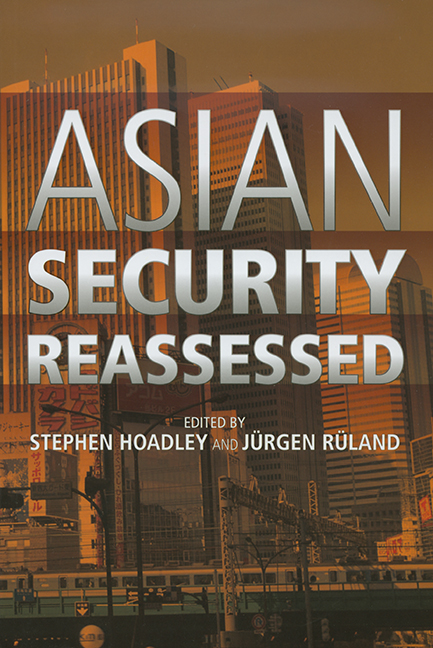Book contents
- Frontmatter
- Contents
- Acknowledgements
- About the Contributors
- List of Abbreviations
- Preface
- Part One Approaches to Asian Security
- Part Two Security Management by Asian States and Regional Institutions
- Part Three Non-Traditional Challenges to Asian Security
- 7 Weapons Proliferation in Asia
- 8 Conflicts over Natural Resources and the Environment
- 9 Ethnic Conflict, Separatism and Terrorism
- 10 Irregular Migration as a Security Issue
- 11 Globalization and Asian Financial Insecurity
- 12 Challenges to Human Rights and Civil Liberties
- Part Four New Concepts of Asian Security
- Index
11 - Globalization and Asian Financial Insecurity
from Part Three - Non-Traditional Challenges to Asian Security
Published online by Cambridge University Press: 21 October 2015
- Frontmatter
- Contents
- Acknowledgements
- About the Contributors
- List of Abbreviations
- Preface
- Part One Approaches to Asian Security
- Part Two Security Management by Asian States and Regional Institutions
- Part Three Non-Traditional Challenges to Asian Security
- 7 Weapons Proliferation in Asia
- 8 Conflicts over Natural Resources and the Environment
- 9 Ethnic Conflict, Separatism and Terrorism
- 10 Irregular Migration as a Security Issue
- 11 Globalization and Asian Financial Insecurity
- 12 Challenges to Human Rights and Civil Liberties
- Part Four New Concepts of Asian Security
- Index
Summary
INTRODUCTION
In the past decade we have witnessed a number of financial crises in Asia and elsewhere. None was predicted but all imposed great economic and social costs on the countries involved directly or indirectly in the crises. The stability of states and the security of their inhabitants were jeopardized. Greater openness of economies, a facet of globalization, thus entails greater instability, vulnerability, and costs not only in the economic sector but in society, politics, and international relations as well. Financial integration has spread, outdistancing methods or mechanisms for assessing the state of countries’ financial sectors and economies in general so that crises could be predicted and costs either prevented or minimized. However, more is learnt from bad experiences than from good ones. This chapter is thus a stock-taking exercise about where we stand today with respect to financial crises, that is, what we know about their causes and how to respond to them. Answers to such questions are essential for providing stability and predictability to the markets, which in turn are necessary (although not always sufficient) conditions for Asian security.
The chapter begins with giving a brief overview of the process of globalization and its different aspects. The rest of the chapter is organized as follows. An overview of potential benefits and costs of open financial markets is given prior to discussing the nature and types of financial crises as one of the more serious globalization-driven threats to security. This is followed by a detailed account of the Asian crisis of 1997–98. While the Asian crisis was indeed triggered by an overvalued Thai baht in July 1997, there is a host of contributing factors leading to this triggering moment and inducing the crisis to spread. There is a broad consensus on what caused the Asian crisis. It was different from other crises because its origin was found in imbalances of the private sector across the region. Nevertheless, the crucial question remains why the policymakers in the East and Southeast Asian countries, which managed their economies so well before, and not at all so badly since, did not see the crisis coming. There is a set of policy prerequisites that may allow governments better to manage the risks while still letting their countries enjoy the benefits of open financial markets.
- Type
- Chapter
- Information
- Asian Security Reassessed , pp. 270 - 290Publisher: ISEAS–Yusof Ishak InstitutePrint publication year: 2006



